
History of construction
Encyclopedia
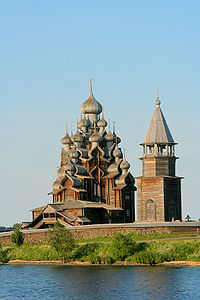
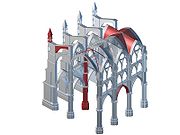
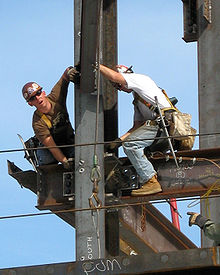
Construction
In the fields of architecture and civil engineering, construction is a process that consists of the building or assembling of infrastructure. Far from being a single activity, large scale construction is a feat of human multitasking...
building
Building
In architecture, construction, engineering, real estate development and technology the word building may refer to one of the following:...
s and other structures since prehistory
Prehistory
Prehistory is the span of time before recorded history. Prehistory can refer to the period of human existence before the availability of those written records with which recorded history begins. More broadly, it refers to all the time preceding human existence and the invention of writing...
, including bridges, amphitheatres, dams, electricity pylons, roads and canals. Building materials in present use have a long history and some of the structures built thousands of years ago can still be regarded as remarkable. The history of construction overlaps that of structural engineering
Structural engineering
Structural engineering is a field of engineering dealing with the analysis and design of structures that support or resist loads. Structural engineering is usually considered a specialty within civil engineering, but it can also be studied in its own right....
. To understand why things were constructed the way they were, we also need to rely on archaeology
Archaeology
Archaeology, or archeology , is the study of human society, primarily through the recovery and analysis of the material culture and environmental data that they have left behind, which includes artifacts, architecture, biofacts and cultural landscapes...
to record the form of the parts that survive and the tools used, and other branches of history
History
History is the discovery, collection, organization, and presentation of information about past events. History can also mean the period of time after writing was invented. Scholars who write about history are called historians...
and architecture
Architecture
Architecture is both the process and product of planning, designing and construction. Architectural works, in the material form of buildings, are often perceived as cultural and political symbols and as works of art...
to investigate how the builders lived and recorded their accomplishments.
Chronological development
The history of construction is a complex subject encompassing the history of building materials, the history of engineering, the history of building techniques, economic and social history of builders and workmen, the history of construction machinery and temporary works, etc. Each of these has a complex literature devoted to it.Neolithic construction
The first bridgeBridge
A bridge is a structure built to span physical obstacles such as a body of water, valley, or road, for the purpose of providing passage over the obstacle...
s made by humans were probably wooden logs placed across a stream. The first buildings were simple hut
Hut (dwelling)
A hut is a small and crude shelter, usually used for dwelling. Its design favors local techniques and materials to allow for swift and inexpensive construction.-Modern use:...
s, tent
Tent
A tent is a shelter consisting of sheets of fabric or other material draped over or attached to a frame of poles or attached to a supporting rope. While smaller tents may be free-standing or attached to the ground, large tents are usually anchored using guy ropes tied to stakes or tent pegs...
s and shelters meant to suit the basic needs of protection from the elements, built by their inhabitants (see self-sufficiency
Self-sufficiency
Self-sufficiency refers to the state of not requiring any outside aid, support, or interaction, for survival; it is therefore a type of personal or collective autonomy...
). The very simplest shelters, tents, leave no traces. Because of this, what little we can say about very early construction is mostly conjecture and based on what we know about the way nomadic hunter-gatherers and herdsmen in remote areas build shelters today. The absence of metal tools placed limitations on the materials that could be worked, but it was still possible to build quite elaborate stone structures with ingenuity using dry-stone-walling techniques (see the stone structures at Skara Brae
Skara Brae
Skara Brae is a large stone-built Neolithic settlement, located on the Bay of Skaill on the west coast of Mainland, Orkney, Scotland. It consists of ten clustered houses, and was occupied from roughly 3180 BCE–2500 BCE...
. The first mud bricks, formed with the hands rather than wooden moulds, belong to the late Neolithic period and were found in Jericho
Jericho
Jericho ; is a city located near the Jordan River in the West Bank of the Palestinian territories. It is the capital of the Jericho Governorate and has a population of more than 20,000. Situated well below sea level on an east-west route north of the Dead Sea, Jericho is the lowest permanently...
. One of the largest structures of this period was the Neolithic long house
Neolithic long house
The Neolithic long house was a long, narrow timber dwelling built by the first farmers in Europe beginning at least as early as the period 5000 to 6000 BC. This type of architecture represents the largest free-standing structure in the world in its era...
. In all cases of timber structures in these very early cultures, only the very lowest parts of the walls and post-holes are unearthed in archaeological excavations, making reconstruction of the upper parts of these buildings purely conjectural. The most remarkable Neolithic structure in Western Europe is the iconic monument known as Stonehenge, regarded by some archaeologists as displaying methods of timber construction translated into stone. The now ruinous remains include massive sandstone lintels which were located on supporting uprights by means of mortise and tenon joints; the lintels themselves being end-jointed by the use of toggle joints (tongue and groove). There is also evidence of prefabrication of the stonework; the symmetrical geometric arrays of stone clearly indicate that the builders of Stonehenge had mastered sophisticated surveying methods.
Construction in ancient Mesopotamia
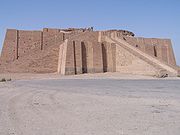
Mesopotamia
Mesopotamia is a toponym for the area of the Tigris–Euphrates river system, largely corresponding to modern-day Iraq, northeastern Syria, southeastern Turkey and southwestern Iran.Widely considered to be the cradle of civilization, Bronze Age Mesopotamia included Sumer and the...
. The smaller dwellings only survive in traces of foundations, but the later civilisations built very sizeable structures in the forms of palaces, temples and ziggurat
Ziggurat
Ziggurats were massive structures built in the ancient Mesopotamian valley and western Iranian plateau, having the form of a terraced step pyramid of successively receding stories or levels.Notable ziggurats include the Great Ziggurat of Ur near Nasiriyah, Iraq; the Ziggurat of Aqar Quf near...
s and took particular care to build them out of materials that last, which has ensured that very considerable parts have remained intact. Major technical achievement is evidenced by the construction of great cities such as Uruk
Uruk
Uruk was an ancient city of Sumer and later Babylonia, situated east of the present bed of the Euphrates river, on the ancient dry former channel of the Euphrates River, some 30 km east of modern As-Samawah, Al-Muthannā, Iraq.Uruk gave its name to the Uruk...
and Ur
Ur
Ur was an important city-state in ancient Sumer located at the site of modern Tell el-Muqayyar in Iraq's Dhi Qar Governorate...
. The Ziggurat of Ur is an outstanding building of the period, despite major reconstruction work. Another fine example is the ziggurat at Chogha Zanbil in modern Iran.
Materials
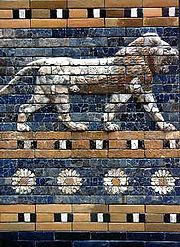
Adobe
Adobe is a natural building material made from sand, clay, water, and some kind of fibrous or organic material , which the builders shape into bricks using frames and dry in the sun. Adobe buildings are similar to cob and mudbrick buildings. Adobe structures are extremely durable, and account for...
). Bricks varied widely in size and format from small bricks that could be lifted in one hand to ones as big as large paving slabs. Rectangular and square bricks were both common. They were laid in virtually every bonding pattern imaginable and used with considerable sophistication. Drawings survive on clay tablets from later periods showing that buildings were set out on brick modules. By 3500 BC, bricks were also being fired and surviving records show a very complex division of labour into separate tasks and trades. Life in general was governed by complex ritual and this extended to rituals for setting-out buildings and moulding the first bricks. Contrary to popular belief the arch was not invented by the Romans, but was used in these civilizations. The later Mesopotamian civilizations, particularly Babylon
Babylon
Babylon was an Akkadian city-state of ancient Mesopotamia, the remains of which are found in present-day Al Hillah, Babil Province, Iraq, about 85 kilometers south of Baghdad...
and thence Susa
Susa
Susa was an ancient city of the Elamite, Persian and Parthian empires of Iran. It is located in the lower Zagros Mountains about east of the Tigris River, between the Karkheh and Dez Rivers....
, developed glazed brickwork to a very high degree, decorating the interiors and exteriors of their buildings with glazed brick reliefs, examples of which survive in the Tehran archaeological museum, the Louvre
Louvre
The Musée du Louvre – in English, the Louvre Museum or simply the Louvre – is one of the world's largest museums, the most visited art museum in the world and a historic monument. A central landmark of Paris, it is located on the Right Bank of the Seine in the 1st arrondissement...
Museum in Paris and the Pergamon Museum
Pergamon Museum
The Pergamon Museum is situated on the Museum Island in Berlin. The site was designed by Alfred Messel and Ludwig Hoffmann and was constructed in twenty years, from 1910 to 1930. The Pergamon houses original-sized, reconstructed monumental buildings such as the Pergamon Altar and the Market Gate...
in Berlin.
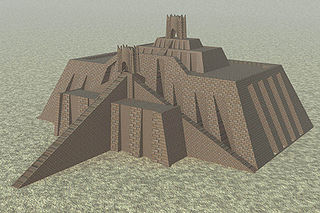
Construction in ancient Egypt
As opposed to the cultures of ancient Mesopotamia which built in brick, the pharaohs of Egypt built huge structures in stone. The arid climate has preserved much of the ancient buildings.Materials
AdobeAdobe
Adobe is a natural building material made from sand, clay, water, and some kind of fibrous or organic material , which the builders shape into bricks using frames and dry in the sun. Adobe buildings are similar to cob and mudbrick buildings. Adobe structures are extremely durable, and account for...
(sun-baked mud brick) construction was used for ancillary buildings and normal houses in ancient times and is still commonly used in rural Egypt. The hot, dry climate was ideal for mud-brick, which tends to wash away in the rain. The Ramesseum
Ramesseum
The Ramesseum is the memorial temple of Pharaoh Ramesses II . It is located in the Theban necropolis in Upper Egypt, across the River Nile from the modern city of Luxor...
in Thebes, Egypt
Thebes, Egypt
Thebes is the Greek name for a city in Ancient Egypt located about 800 km south of the Mediterranean, on the east bank of the river Nile within the modern city of Luxor. The Theban Necropolis is situated nearby on the west bank of the Nile.-History:...
(Luxor) provides one of the finest examples of mud brick construction. Extensive storehouses with mud-brick vaults also survive, all constructed with sloping courses to avoid the need for formwork.
The grandest buildings were constructed in stone, often from massive masonry blocks. The techniques used to move massive blocks used in pyramids and temples have been subject to extensive debate. Some authors have suggested that the larger blocks may not be cut stone but fabricated with concrete.
Technology
Although the Egyptians achieved extraordinary feats of engineering, they appear to have done so with relatively primitive technology. As far as is known they did not use wheels or pulleys. They transported massive stones over great distances using rollers, ropes and sledges hauled by large numbers of slaves. There are no surviving Egyptian manuals so there has been considerable speculation on how stones were lifted to great heights and obelisks erected. Most theories centre on the use of ramps.Outstanding achievements

Pyramid
A pyramid is a structure whose outer surfaces are triangular and converge at a single point. The base of a pyramid can be trilateral, quadrilateral, or any polygon shape, meaning that a pyramid has at least three triangular surfaces...
s are chiefly impressive for their enormous size and the staggering manpower that must have been employed in their construction. The largest is the Great Pyramid of Giza
Great Pyramid of Giza
The Great Pyramid of Giza is the oldest and largest of the three pyramids in the Giza Necropolis bordering what is now El Giza, Egypt. It is the oldest of the Seven Wonders of the Ancient World, and the only one to remain largely intact...
which remained the tallest structure in the world for 3800 years (see List of tallest freestanding structures in the world). The engineering problems involved were chiefly to do with the transport of blocks, sometimes over long distances, their movement into location and exact alignment. It is now generally agreed that the skilled building workers were respected and well treated, but undoubtedly very large numbers of labourers were necessary to provide the brute force.
The methods used in the construction of the pyramids have been the subject of considerable research and discussion (see: Egyptian pyramid construction techniques
Egyptian pyramid construction techniques
There have been many hypotheses about the Egyptian pyramid construction techniques. These techniques seem to have developed over time; later pyramids were not built the same way as earlier ones. Most of the construction hypotheses are based on the idea that huge stones were carved with copper...
).
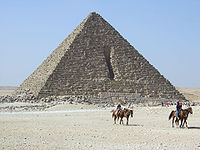
Construction in ancient Greece
The ancient Greeks, like the Egyptians and the Mesopotamians,tended to build most of their common buildings out of mud brick, leaving no record behind them. However very many structures do survive, some of which are in a very good state of repair, although some have been partly reconstructed or re-erected in the modern era. The most dramatic are the Greek TempleGreek temple
Greek temples were structures built to house deity statues within Greek sanctuaries in Greek paganism. The temples themselves did usually not directly serve a cult purpose, since the sacrifices and rituals dedicated to the respective deity took place outside them...
s.
No timber structures survive (roofs, floors etc.), so our knowledge of how these were put together is purely conjectural. The spans are, in the main, limited and suggest very simple beam and post structures spanning stone walls.
Fire clay
Fire clay
Fire clay is a term applied to a range of refractory clays used in the manufacture of ceramics, especially fire brick.High grade fire clays can withstand temperatures of 1775°C , but to be referred to as a "fire clay" the material must withstand a minimum temperature of 1515°C...
was mainly restricted to roofing tiles and associated decorations, but these were quite elaborate. Fired bricks were not commonly employed. Very prominent buildings were roofed in stone tiles, which mimicked the form of their terracotta counterparts. While later cultures tended to construct their stone buildings with thin skins of finished stones over rubble cores, the Greeks tended to build out of large cut blocks, joined with metal cramps. This was a slow, expensive and laborious process which limited the number of buildings that could be constructed. The metal cramps often failed through corrosion.
Building structures used a simple beam and column system without vaults or arches, which based strict limits on the spans that could achieved. However, the Greeks did construct Arch Bridge
Arch bridge
An arch bridge is a bridge with abutments at each end shaped as a curved arch. Arch bridges work by transferring the weight of the bridge and its loads partially into a horizontal thrust restrained by the abutments at either side...
s.
Greek mathematics was technically advanced and we know for certain that they employed and understood the principles of pulley
Pulley
A pulley, also called a sheave or a drum, is a mechanism composed of a wheel on an axle or shaft that may have a groove between two flanges around its circumference. A rope, cable, belt, or chain usually runs over the wheel and inside the groove, if present...
s, which would have enabled them to build gibs and cranes to lift heavy stonework to the upper parts of buildings. Their surveying skills were exceptional, enabling them to set out the incredibly exact optical corrections of buildings like the Parthenon
Parthenon
The Parthenon is a temple on the Athenian Acropolis, Greece, dedicated to the Greek goddess Athena, whom the people of Athens considered their virgin patron. Its construction began in 447 BC when the Athenian Empire was at the height of its power. It was completed in 438 BC, although...
, although the methods used remain a mystery. Simpler decoration, such as fluting on columns, was simply left until the drums of the columns were cut in place.
The ancient Greeks never developed the strong mortars which became an important feature of Roman construction.
Roman construction
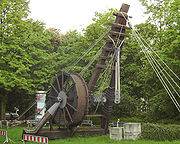

Pantheon, Rome
The Pantheon ,Rarely Pantheum. This appears in Pliny's Natural History in describing this edifice: Agrippae Pantheum decoravit Diogenes Atheniensis; in columnis templi eius Caryatides probantur inter pauca operum, sicut in fastigio posita signa, sed propter altitudinem loci minus celebrata.from ,...
and very well preserved ruins at Pompeii
Pompeii
The city of Pompeii is a partially buried Roman town-city near modern Naples in the Italian region of Campania, in the territory of the comune of Pompei. Along with Herculaneum, Pompeii was destroyed and completely buried during a long catastrophic eruption of the volcano Mount Vesuvius spanning...
and Herculaneum
Herculaneum
Herculaneum was an ancient Roman town destroyed by volcanic pyroclastic flows in AD 79, located in the territory of the current commune of Ercolano, in the Italian region of Campania in the shadow of Mt...
. We also have the first surviving treatise on architecture by Vitruvius
Vitruvius
Marcus Vitruvius Pollio was a Roman writer, architect and engineer, active in the 1st century BC. He is best known as the author of the multi-volume work De Architectura ....
which includes extensive passages on construction techniques.
Materials
The great Roman breakthrough was the development of hydraulic lime mortarLime mortar
Lime mortar is a type of mortar composed of lime and an aggregate such as sand, mixed with water. It is one of the oldest known types of mortar, dating back to the 4th century BC and widely used in Ancient Rome and Greece, when it largely replaced the clay and gypsum mortars common to Ancient...
. Previous cultures had used lime mortars but by adding volcanic ash the Romans managed to make a mortar that would harden under water. This provided them with a cheap material for bulk walling. They used brick or stone to build the outer skins of the wall and then filled the cavity with massive amounts of concrete
Concrete
Concrete is a composite construction material, composed of cement and other cementitious materials such as fly ash and slag cement, aggregate , water and chemical admixtures.The word concrete comes from the Latin word...
, effectively using the brickwork as permanent shuttering. The concrete, being formed of nothing more than rubble and mortar was cheap and very easy to produce, requiring relatively unskilled labour, enabling the Romans to build on an unprecedented scale. They not only used it for walls but also to form arch
Arch
An arch is a structure that spans a space and supports a load. Arches appeared as early as the 2nd millennium BC in Mesopotamian brick architecture and their systematic use started with the Ancient Romans who were the first to apply the technique to a wide range of structures.-Technical aspects:The...
es, barrel vaults and dome
Dome
A dome is a structural element of architecture that resembles the hollow upper half of a sphere. Dome structures made of various materials have a long architectural lineage extending into prehistory....
s, which they built over huge spans. The Romans developed systems of hollow pots for making their domes and sophisticated heating and ventilation systems for their thermal baths. Glass was commonly used in windows.
Organisation of labour
The Romans had trade guilds. Most construction was done by slaves or freed men. The use of slave labour undoubtedly cut costs and was one of the reasons for the scale of some of the structures. The Romans placed a considerable emphasis in building their buildings extremely fast, usually within two years. For very large structures the only way this could be achieved was by the application of vast numbers of workers to the task.Technology
VitruviusVitruvius
Marcus Vitruvius Pollio was a Roman writer, architect and engineer, active in the 1st century BC. He is best known as the author of the multi-volume work De Architectura ....
gives details of many Roman machines. The Romans developed sophisticated timber cranes allowing them to lift considerable weights to great heights. The upper limit of lifting appears to have been about 100 tonnes. Trajan's column in Rome contains some of the largest stones ever lifted in a Roman building, and engineers are still uncertain exactly how it was achieved.
A list of the longest, highest and deepest Roman structures can be found in the List of ancient architectural records.
Roman building ingenuity extended over bridge
Bridge
A bridge is a structure built to span physical obstacles such as a body of water, valley, or road, for the purpose of providing passage over the obstacle...
s, aqueduct
Aqueduct
An aqueduct is a water supply or navigable channel constructed to convey water. In modern engineering, the term is used for any system of pipes, ditches, canals, tunnels, and other structures used for this purpose....
s, and covered amphitheatre
Amphitheatre
An amphitheatre is an open-air venue used for entertainment and performances.There are two similar, but distinct, types of structure for which the word "amphitheatre" is used: Ancient Roman amphitheatres were large central performance spaces surrounded by ascending seating, and were commonly used...
s. Their sewerage and water-supply works were remarkable and some systems are still in operation today. The only aspect of Roman construction for which very little evidence survives is the form of timber roof structures, none of which seem to have survived intact. Possibly, triangulated roof trusses were built, this being the only conceivable way of constructing the immense spans achieved, the longest exceeding 30 metres (see List of ancient roofs).
Medieval construction
In the Middle AgesMiddle Ages
The Middle Ages is a periodization of European history from the 5th century to the 15th century. The Middle Ages follows the fall of the Western Roman Empire in 476 and precedes the Early Modern Era. It is the middle period of a three-period division of Western history: Classic, Medieval and Modern...
of Europe fortification
Fortification
Fortifications are military constructions and buildings designed for defence in warfare and military bases. Humans have constructed defensive works for many thousands of years, in a variety of increasingly complex designs...
s, castle
Castle
A castle is a type of fortified structure built in Europe and the Middle East during the Middle Ages by European nobility. Scholars debate the scope of the word castle, but usually consider it to be the private fortified residence of a lord or noble...
s and cathedrals were the greatest construction projects. The Roman building techniques were lost. (But Roman techniques, including the use of iron ring-beams, would appear to have been used in the Palatine Chapel at Aachen, c. 800 AD, where it is believed builders from the Langobard Kingdom in northern Italy contributed to the work.
Materials
Most buildings in Northern Europe were constructed of timber until c. 1000 AD. In Southern Europe adobe remained predominant. Brick continued to be manufactured in Italy throughout the period 600-1000 AD but elsewhere the craft of brickmaking had largely disappeared and with it the methods for burning tiles. Roofs were largely thatched. Houses were small and gathered around a large communal hall. Monasticism spread more sophisticated building techniques. The Cistercians may have been responsible for reintroducing brickmaking to the area from Holland, through Denmark and Northern Germany to Poland leading to Backsteingotik. Brick remained the most popular prestige material in these areas throughout the period. Elsewhere buildings were typically in timber or where it could be afforded, stone. Medieval stone walls were constructed using cut blocks on the outside of the walls and rubble infill, with weak lime mortarLime mortar
Lime mortar is a type of mortar composed of lime and an aggregate such as sand, mixed with water. It is one of the oldest known types of mortar, dating back to the 4th century BC and widely used in Ancient Rome and Greece, when it largely replaced the clay and gypsum mortars common to Ancient...
s. The poor hardening properties of these mortars were a continual problem, and the settlement of the rubble filling of Romanesque
Romanesque architecture
Romanesque architecture is an architectural style of Medieval Europe characterised by semi-circular arches. There is no consensus for the beginning date of the Romanesque architecture, with proposals ranging from the 6th to the 10th century. It developed in the 12th century into the Gothic style,...
and Gothic
Gothic architecture
Gothic architecture is a style of architecture that flourished during the high and late medieval period. It evolved from Romanesque architecture and was succeeded by Renaissance architecture....
walls and piers is still a major cause for concern.
Design

Labour
In general, medieval buildings were built by paid workers. Unskilled work was done by labourers paid by the day. Skilled craftsmen served apprenticeships or learned their trade from their parents. It is not clear how many women were members of a guild holding a monopoly on a particular trade in a defined area (usually within the town walls). Towns were in general very small by modern standards and dominated by the dwellings of a small number of rich nobles or merchants, and by cathedrals and churches.Techniques
Romanesque buildings of the period 600-1100 AD were entirely roofed in timber or had stone barrel vaults covered by timber roofs. The Gothic style of architecture with its vaultsVault (architecture)
A Vault is an architectural term for an arched form used to provide a space with a ceiling or roof. The parts of a vault exert lateral thrust that require a counter resistance. When vaults are built underground, the ground gives all the resistance required...
, flying buttresses and pointed gothic arches developed in the twelfth century and in the centuries that followed ever more incredible feats of constructional daring were achieved in stone. Thin stone vaults and towering buildings were constructed using rules derived by trial and error. Failures were frequent, particularly in difficult areas such as crossing towers.
The pile driver
Pile driver
A pile driver is a mechanical device used to drive piles into soil to provide foundation support for buildings or other structures. The term is also used in reference to members of the construction crew that work with pile-driving rigs....
was invented around 1500.
Outstanding technical achievements
The scale of fortifications and castleCastle
A castle is a type of fortified structure built in Europe and the Middle East during the Middle Ages by European nobility. Scholars debate the scope of the word castle, but usually consider it to be the private fortified residence of a lord or noble...
building in the Middle Ages was remarkable, but the outstanding buildings of the period were the Gothic cathedrals with thin masonry vaults and walls of glass. Outstanding examples are: Beauvais Cathedral, Chartres Cathedral, King's College Chapel and Notre Dame, Paris.
Construction in the Renaissance
The RenaissanceRenaissance
The Renaissance was a cultural movement that spanned roughly the 14th to the 17th century, beginning in Italy in the Late Middle Ages and later spreading to the rest of Europe. The term is also used more loosely to refer to the historical era, but since the changes of the Renaissance were not...
in Italy, the invention of moveable type and the Reformation
Reformation
- Movements :* Protestant Reformation, an attempt by Martin Luther to reform the Roman Catholic Church that resulted in a schism, and grew into a wider movement...
changed the character of building. The rediscovery of Vitruvius had a strong influence. During the Middle Ages buildings were designed by the people that built them. The master mason and master carpenters learnt their trades by word of mouth and relied on experience, models and rules of thumb to determine the sizes of building elements. Vitruvius however describes in detail the education of the perfect architect who, he said, must be skilled in all the arts and sciences. Filippo Brunelleschi
Filippo Brunelleschi
Filippo Brunelleschi was one of the foremost architects and engineers of the Italian Renaissance. He is perhaps most famous for inventing linear perspective and designing the dome of the Florence Cathedral, but his accomplishments also included bronze artwork, architecture , mathematics,...
was one of the first of the new style of architects. He started life as a goldsmith and educated himself in Roman architecture by studying ruins. He went on to engineer the dome of Santa Maria del Fiore
Santa Maria del Fiore
The Basilica di Santa Maria del Fiore is the cathedral church of Florence, Italy. The Duomo, as it is ordinarily called, was begun in 1296 in the Gothic style to the design of Arnolfo di Cambio and completed structurally in 1436 with the dome engineered by Filippo Brunelleschi...
in Florence.
Materials
The major breakthroughs in this period were to do with the technology of conversion. Water mills in most of western Europe were used to saw timber and convert trees into planks. Bricks were used in ever increasing quantities. In Italy the brickmakers were organised into guilds although the kilns were mostly in rural areas because of the risk of fire and easy availability of firewood and brickearth. Brickmakers were typically paid by the brick, which gave them an incentive to make them too small. As a result, legislation was laid down regulating the minimum sizes and each town kept measures against which bricks had to be compared. An increasing amount of ironwork was used in roof carpentry for straps and tension members. The iron was fixed using forelock bolts. The screw-threaded bolt (and nut) could be made and are found in clockmaking in this period, but they were labour intensive and thus not used on large structures. Roofing was typically of terracotta roof tiles. In Italy they followed Roman precedents. In northern Europe plain tiles were used. Stone, where available, remained the material of choice for prestige buildings.Design
The rebirth of the idea of an architect in the Renaissance radically changed the nature of building design. The Renaissance reintroduced the classical style of architecture. Leon Battista Alberti's treatise on architecture raised the subject to a new level, defining architecture as something worthy of study by the aristocracy. Previously it was viewed merely as a technical art, suited only to the artisan. The resulting change in status of architecture and more importantly the architect is key to understanding the changes in the process of design. The Renaissance architect was often an artist (a painter or sculptor) who had little knowledge of building technology but a keen grasp of the rules of classical design. The architect thus had to provide detailed drawings for the craftsmen setting out the disposition of the various parts. This was what we call the process of design, from the Italian word for drawing. Occasionally the architect would get involved in particularly difficult technical problems but the technical side of architecture was mainly left up to the craftsmen. This change in the way buildings were designed had a fundamental difference on the way problems were approached. Where the Medieval craftsmen tended to approach a problem with a technical solution in mind, the Renaissance architect started with an idea of the what the end product needed to look like and then searched around for a way of making it work. This led to extraordinary leaps forward in engineering.Labour
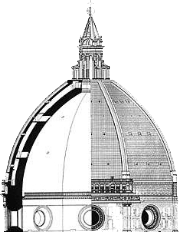
Guild
A guild is an association of craftsmen in a particular trade. The earliest types of guild were formed as confraternities of workers. They were organized in a manner something between a trade union, a cartel, and a secret society...
s which provided a limited form of building regulation in return for members of the guild holding a monopoly on a particular trade in a defined area (usually within the town walls). Towns were in general very small by modern standards and dominated by the dwellings of a small number of rich nobles or merchants and cathedrals and churches.
Technical advances
The wish to return to classical architecture created problems for the Renaissance buildings. The builders did not use concrete and thus comparable vaults and domes had to be replicated in brick or stone. The greatest technical feats were undoubtedly in these areas. The first major breakthrough was Brunelleschi's project for the domeDome
A dome is a structural element of architecture that resembles the hollow upper half of a sphere. Dome structures made of various materials have a long architectural lineage extending into prehistory....
of Santa Maria del Fiore
Santa Maria del Fiore
The Basilica di Santa Maria del Fiore is the cathedral church of Florence, Italy. The Duomo, as it is ordinarily called, was begun in 1296 in the Gothic style to the design of Arnolfo di Cambio and completed structurally in 1436 with the dome engineered by Filippo Brunelleschi...
. Brunelleschi managed to devise a way of building a huge dome without formwork, relying instead on the weight of the bricks and the way they were laid to keep them in position and the shape of the dome to keep it standing. The exact way the dome was built is still subject to debate today as it is not possible to take the dome apart to study its construction without destroying it. The dome is a double skin, linked by ribs, with a series of wooden and stone chains around it at intervals to attempt to deal with hoop stresses.
Brunelleschi's dome was completed (up to the base of the lantern) in 1446. Its size was soon surpassed by the dome of St Peter's, built using flying scaffolding supported on the cornices and constructed using two stone shells.
Construction in the seventeenth century
The seventeenth century saw the birth of modern science which would have profound effects on building construction in the centuries to come. The major breakthroughs were towards the end of the century when architect-engineers began to use experimental science to inform the form of their buildings. However it was not until the eighteenth century that engineering theory developed sufficiently to allow sizes of members to be calculated. Seventeenth-century structures relied strongly on experience, rules of thumb and the use of scale models.Materials and tools
The major breakthrough in this period was in the manufacture of glassGlass
Glass is an amorphous solid material. Glasses are typically brittle and optically transparent.The most familiar type of glass, used for centuries in windows and drinking vessels, is soda-lime glass, composed of about 75% silica plus Na2O, CaO, and several minor additives...
, with the first cast plate glass being developed in France. Iron was increasingly employed in structures. Christopher Wren
Christopher Wren
Sir Christopher Wren FRS is one of the most highly acclaimed English architects in history.He used to be accorded responsibility for rebuilding 51 churches in the City of London after the Great Fire in 1666, including his masterpiece, St. Paul's Cathedral, on Ludgate Hill, completed in 1710...
used iron hangers to suspend floor beams at Hampton Court Palace
Hampton Court Palace
Hampton Court Palace is a royal palace in the London Borough of Richmond upon Thames, Greater London; it has not been inhabited by the British royal family since the 18th century. The palace is located south west of Charing Cross and upstream of Central London on the River Thames...
, and iron rods to repair Salisbury Cathedral
Salisbury Cathedral
Salisbury Cathedral, formally known as the Cathedral Church of the Blessed Virgin Mary, is an Anglican cathedral in Salisbury, England, considered one of the leading examples of Early English architecture....
and strengthen the dome of St Paul's Cathedral
St Paul's Cathedral
St Paul's Cathedral, London, is a Church of England cathedral and seat of the Bishop of London. Its dedication to Paul the Apostle dates back to the original church on this site, founded in AD 604. St Paul's sits at the top of Ludgate Hill, the highest point in the City of London, and is the mother...
. Most buildings had stone ashlar
Ashlar
Ashlar is prepared stone work of any type of stone. Masonry using such stones laid in parallel courses is known as ashlar masonry, whereas masonry using irregularly shaped stones is known as rubble masonry. Ashlar blocks are rectangular cuboid blocks that are masonry sculpted to have square edges...
surfaces covering rubble cores, held together with lime mortar. Experiments were made mixing lime with other materials to provide a hydraulic mortar, but there was still no equivalent of the Roman concrete. In England, France and Holland, cut and gauged brickwork was used to provide detailed and ornate facades. The triangulated roof truss was introduced to England and used by Inigo Jones
Inigo Jones
Inigo Jones is the first significant British architect of the modern period, and the first to bring Italianate Renaissance architecture to England...
and Christopher Wren
Christopher Wren
Sir Christopher Wren FRS is one of the most highly acclaimed English architects in history.He used to be accorded responsibility for rebuilding 51 churches in the City of London after the Great Fire in 1666, including his masterpiece, St. Paul's Cathedral, on Ludgate Hill, completed in 1710...
.
Many tools have been made obsolete by modern technology, but the line gauge
Ruler
A ruler, sometimes called a rule or line gauge, is an instrument used in geometry, technical drawing, printing and engineering/building to measure distances and/or to rule straight lines...
, plumb-line, the carpenter's square
Steel square
The steel square is a tool that carpenters use. They use many tools to lay out a "square" or right-angle, many of which are made of steel, but the title steel square refers to a specific long-armed square that has additional uses for measurement, especially of angles, as well as simple...
, the spirit level
Spirit level
A spirit level or bubble level is an instrument designed to indicate whether a surface ishorizontal or vertical . Different types of spirit levels may be used by carpenters, stonemasons, bricklayers, other building trades workers, surveyors, millwrights and other metalworkers, and in some...
, the slide-rule and the drafting compass
Compass (drafting)
A compass or pair of compasses is a technical drawing instrument that can be used for inscribing circles or arcs. As dividers, they can also be used as a tool to measure distances, in particular on maps...
are still in regular use.
Methods
Despite the birth of experimental science, the methods of construction in this period remained largely medieval. The same types of crane that had been used in previous centuries were being still being employed. Flying scaffolds were employed at St Paul's Cathedral, England and in the dome of St Peters, Rome, but otherwise the same types of timber scaffolding that had been in use centuries before were retained. Cranes and scaffolding depended on timber. Complex systems of pulleys allowed comparatively large loads to be lifted, and long ramps were used to haul loads up to the upper parts of buildings.Construction in the eighteenth century
The eighteenth century saw the development of many the ideas that had been born in the late seventeenth century. The architects and engineers became increasingly professionalised. Experimental science and mathematical methods began increasingly sophisticated and employed in buildings. At the same time the birth of the industrial revolution saw an increase in the size of cities and increase in the pace and quantity of construction.Materials
The major breakthroughs in this period were in the use of iron (both cast and wrought). Iron columns had been used in Wren's designs for the House of Commons and were used in several early eighteenth-century churches in London, but these supported only galleries. In the second half of the eighteenth century the decreasing costs of iron production allowed the construction of major pieces of iron engineering. The Iron Bridge at Coalbrookdale (1779) is a particularly notable example. Large-scale mill construction required fire-proof buildings and cast iron became increasingly used for columns and beams to carry brick vaults for floors. The Louvre in Paris boasted an early example of a wrought-iron roof. Steel was used in the manufacture of tools but could not be made in sufficient quantities to be used for building.Brick production increased markedly during this period. Many buildings throughout Europe were built of brick, but they were often coated in lime render, sometimes patterned to look like stone. Brick production itself changed little. Bricks were moulded by hand and fired in kilns no different to those used for centuries before. Terracotta in the form of Coade stone
Coade stone
Lithodipyra , or Coade stone, was ceramic stoneware that was often described as an artificial stone in the late 18th and early 19th centuries. It was used for moulding Neoclassical statues, architectural decorations and garden ornaments that were both of the highest quality and remain virtually...
was used as an artificial stone in the UK.
Construction in the nineteenth century: Industrial Revolution
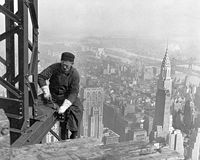
Industrial Revolution
The Industrial Revolution was a period from the 18th to the 19th century where major changes in agriculture, manufacturing, mining, transportation, and technology had a profound effect on the social, economic and cultural conditions of the times...
was manifested in new kinds of transportation installations, such as railways, canal
Canal
Canals are man-made channels for water. There are two types of canal:#Waterways: navigable transportation canals used for carrying ships and boats shipping goods and conveying people, further subdivided into two kinds:...
s and macadam
Macadam
Macadam is a type of road construction pioneered by the Scotsman John Loudon McAdam in around 1820. The method simplified what had been considered state-of-the-art at that point...
roads. These required large amounts of investment
Investment
Investment has different meanings in finance and economics. Finance investment is putting money into something with the expectation of gain, that upon thorough analysis, has a high degree of security for the principal amount, as well as security of return, within an expected period of time...
. New construction devices included steam engine
Steam engine
A steam engine is a heat engine that performs mechanical work using steam as its working fluid.Steam engines are external combustion engines, where the working fluid is separate from the combustion products. Non-combustion heat sources such as solar power, nuclear power or geothermal energy may be...
s, machine tools, explosives and optical surveying
Surveying
See Also: Public Land Survey SystemSurveying or land surveying is the technique, profession, and science of accurately determining the terrestrial or three-dimensional position of points and the distances and angles between them...
.
As steel
Steel
Steel is an alloy that consists mostly of iron and has a carbon content between 0.2% and 2.1% by weight, depending on the grade. Carbon is the most common alloying material for iron, but various other alloying elements are used, such as manganese, chromium, vanadium, and tungsten...
was mass-produced from the mid-19th century, it was used, in form of I-beam
I-beam
-beams, also known as H-beams, W-beams , rolled steel joist , or double-T are beams with an - or H-shaped cross-section. The horizontal elements of the "" are flanges, while the vertical element is the web...
s and reinforced concrete
Reinforced concrete
Reinforced concrete is concrete in which reinforcement bars , reinforcement grids, plates or fibers have been incorporated to strengthen the concrete in tension. It was invented by French gardener Joseph Monier in 1849 and patented in 1867. The term Ferro Concrete refers only to concrete that is...
. Glass
Glass
Glass is an amorphous solid material. Glasses are typically brittle and optically transparent.The most familiar type of glass, used for centuries in windows and drinking vessels, is soda-lime glass, composed of about 75% silica plus Na2O, CaO, and several minor additives...
panes also went into mass production, and changed from luxury to every man's property.
Plumbing
Plumbing
Plumbing is the system of pipes and drains installed in a building for the distribution of potable drinking water and the removal of waterborne wastes, and the skilled trade of working with pipes, tubing and plumbing fixtures in such systems. A plumber is someone who installs or repairs piping...
appeared, and gave common access to drinking water
Drinking water
Drinking water or potable water is water pure enough to be consumed or used with low risk of immediate or long term harm. In most developed countries, the water supplied to households, commerce and industry is all of drinking water standard, even though only a very small proportion is actually...
and sewage collection
Sanitary sewer
A sanitary sewer is a separate underground carriage system specifically for transporting sewage from houses and commercial buildings to treatment or disposal. Sanitary sewers serving industrial areas also carry industrial wastewater...
.
Construction in the twentieth century
With the Second Industrial RevolutionSecond Industrial Revolution
The Second Industrial Revolution, also known as the Technological Revolution, was a phase of the larger Industrial Revolution corresponding to the latter half of the 19th century until World War I...
in the early 20th century, elevator
Elevator
An elevator is a type of vertical transport equipment that efficiently moves people or goods between floors of a building, vessel or other structures...
s and cranes
Crane (machine)
A crane is a type of machine, generally equipped with a hoist, wire ropes or chains, and sheaves, that can be used both to lift and lower materials and to move them horizontally. It uses one or more simple machines to create mechanical advantage and thus move loads beyond the normal capability of...
made high rise
High Rise
High Rise is a 1975 novel by J. G. Ballard. It takes place in an ultra-modern, luxury high-rise building.-Plot summary:The building seems to give its well-established tenants all the conveniences and commodities that modern life has to offer: swimming pools, its own school, a supermarket,...
buildings and skyscraper
Skyscraper
A skyscraper is a tall, continuously habitable building of many stories, often designed for office and commercial use. There is no official definition or height above which a building may be classified as a skyscraper...
s possible, while Heavy equipments and power tools decreased the workforce needed. Other new technologies were prefabrication
Prefabrication
Prefabrication is the practice of assembling components of a structure in a factory or other manufacturing site, and transporting complete assemblies or sub-assemblies to the construction site where the structure is to be located...
and computer-aided design
Computer-aided design
Computer-aided design , also known as computer-aided design and drafting , is the use of computer technology for the process of design and design-documentation. Computer Aided Drafting describes the process of drafting with a computer...
.
Trade union
Trade union
A trade union, trades union or labor union is an organization of workers that have banded together to achieve common goals such as better working conditions. The trade union, through its leadership, bargains with the employer on behalf of union members and negotiates labour contracts with...
s were formed to protect construction workers' interests. Personal protective equipment
Personal protective equipment
Personal protective equipment refers to protective clothing, helmets, goggles, or other garment or equipment designed to protect the wearer's body from injury by blunt impacts, electrical hazards, heat, chemicals, and infection, for job-related occupational safety and health purposes, and in...
such as hard hats and earmuffs
Earmuffs
Earmuffs are objects designed to cover a person's ears for protection. They consist of a thermoplastic or metal head-band, that fits over the top of the head, and a pad at each end, to cover the external ears....
also came into use.
From the 20th century, governmental construction projects were used as a part of macroeconomic stimulation policies, especially during the Great depression
Great Depression
The Great Depression was a severe worldwide economic depression in the decade preceding World War II. The timing of the Great Depression varied across nations, but in most countries it started in about 1929 and lasted until the late 1930s or early 1940s...
(see New Deal
New Deal
The New Deal was a series of economic programs implemented in the United States between 1933 and 1936. They were passed by the U.S. Congress during the first term of President Franklin D. Roosevelt. The programs were Roosevelt's responses to the Great Depression, and focused on what historians call...
).
In the end of the 20th century, ecology
Ecology
Ecology is the scientific study of the relations that living organisms have with respect to each other and their natural environment. Variables of interest to ecologists include the composition, distribution, amount , number, and changing states of organisms within and among ecosystems...
, energy conservation
Energy conservation
Energy conservation refers to efforts made to reduce energy consumption. Energy conservation can be achieved through increased efficient energy use, in conjunction with decreased energy consumption and/or reduced consumption from conventional energy sources...
and sustainable development
Sustainable development
Sustainable development is a pattern of resource use, that aims to meet human needs while preserving the environment so that these needs can be met not only in the present, but also for generations to come...
have become more important issues of construction.
Construction history as an academic discipline
There is no established academic discipline of construction history but a growing number of researchers and academics are working in this field, including structural engineers, archaeologists, architects, historians of technology and architectural historians. Although the subject has been studied since the Renaissance and there were a number of important studies in the nineteenth century, it largely went out of fashion in the mid-twentieth century. In the last thirty years there has been an enormous increase in interest in this field, which is vital to the growing practice of building conservation.Early writers on construction history
The earliest surviving book detailing historical building techniques is the treatise of the Roman author, VitruviusVitruvius
Marcus Vitruvius Pollio was a Roman writer, architect and engineer, active in the 1st century BC. He is best known as the author of the multi-volume work De Architectura ....
, but his approach was neither scholarly nor systematic. Much later, in the Renaissance
Renaissance
The Renaissance was a cultural movement that spanned roughly the 14th to the 17th century, beginning in Italy in the Late Middle Ages and later spreading to the rest of Europe. The term is also used more loosely to refer to the historical era, but since the changes of the Renaissance were not...
, Vasari mentions Filippo Brunelleschi
Filippo Brunelleschi
Filippo Brunelleschi was one of the foremost architects and engineers of the Italian Renaissance. He is perhaps most famous for inventing linear perspective and designing the dome of the Florence Cathedral, but his accomplishments also included bronze artwork, architecture , mathematics,...
's interest in researching Roman building techniques, although if he wrote anything on the subject it does not survive. In the seventeenth century, Rusconi's illustrations for his version of Leon Battista Alberti's treatise explicitly show Roman wall construction but most of the interest in antiquity was in understanding its proportions and detail and the architects of the time were content to build using current techniques. While early archaeological studies and topographic works such as the engravings of Giovanni Battista Piranesi
Giovanni Battista Piranesi
Giovanni Battista Piranesi was an Italian artist famous for his etchings of Rome and of fictitious and atmospheric "prisons" .-His Life:...
show Roman
Roman architecture
Ancient Roman architecture adopted certain aspects of Ancient Greek architecture, creating a new architectural style. The Romans were indebted to their Etruscan neighbors and forefathers who supplied them with a wealth of knowledge essential for future architectural solutions, such as hydraulics...
construction they were not explicitly analytical and much of what they do show is made up.
Nineteenth century studies on construction history
In the nineteenth century, lecturers increasingly illustrated their lectures with images of building techniques used in the past and these type of images increasingly appeared in construction text books, such as Rondelet's. The greatest advances however were made by English and French (and later German) architects attempting to understand, record and analyse Gothic buildings. Typical of this type of writing are the works of Robert Willis in England, Viollet-le-Duc in France and Ungewitter in Germany. None of these however were seeking to suggest that the history of construction represented a new approach to the subject of architectural history. August Choisy was perhaps the first author to seriously attempt to undertake such a study.The early twentieth century studies of the construction history
Santiago Heurta has suggested that it was modernism, with its emphasis on the employment of new materials, that abruptly ended the interest in construction history that appeared to have been growing in the last few decades of the nineteenth century and the early years of the twentieth. With the advent of concrete and steel frame construction, architects, who had been the chief audience for such studies, were no longer as interested as they had been in understanding traditional construction, which suddenly appeared redundant. Very little was thus published between 1920 and 1950. The revival of interest started in archaeology with the studies of Roman construction in the 1950s, but it was not until the 1980s that construction history began to emerge as an independent field.The late twentieth century
By the end of the twentieth century, steel and concrete construction were themselves becoming the subject of historical investigation.The Construction History Society was formed in the UK in 1982. It produces the only academic international journal devoted to the subject annually. The First International Congress on Construction History was held in Madrid in 2003. This was followed by the Second International Congress in 2006 in Queens College, Cambridge, England and the Third International Congress held in Cottbus in 2009. The Fourth International Congress is scheduled to be held in Paris in 2012External links
- Construction History Society (International) http://www.constructionhistory.co.uk/
- Construction History Society (USA) http://www.constructionhistorysociety.org/
- Sociedad Espanola de Historia de la Construction (in Spanish) http://www.sedhc.es/
- I. International Congress on Construction History: Congress Page (English) including free online proceedingshttp://www.aq.upm.es/Instituciones/jherrera/construction-history/
- II. International Congress on Construction History: Congress Page (English) including free online proceedings http://www.arct.cam.ac.uk/Arct/Page.aspx?ix=349&p=23&pid=101&prcid=8&ppid=1294
- III. International Congress on Construction History: Congress page (English) including free online proceedings http://www.ch2009.de/ and review http://edoc.hu-berlin.de/kunsttexte/2009-3/hillmann-roman-6/PDF/hillmann.pdf (German)
- IV. International Congress on Construction History: to be held in Paris in 2012 http://www.icch-paris2012.fr/
See also
- History of architectureHistory of architectureThe history of architecture traces the changes in architecture through various traditions, regions, overarching stylistic trends, and dates.-Neolithic architecture:Neolithic architecture is the architecture of the Neolithic period...
- History of water supply and sanitationHistory of water supply and sanitationThis article covers the history of water supply, plumbing, sanitation and sewage collection and disposal.-Ancient age:During the Neolithic, man dug the first permanent water wells, from where vessels could be filled and carried by hand. The size of human settlements was largely dependent on nearly...

